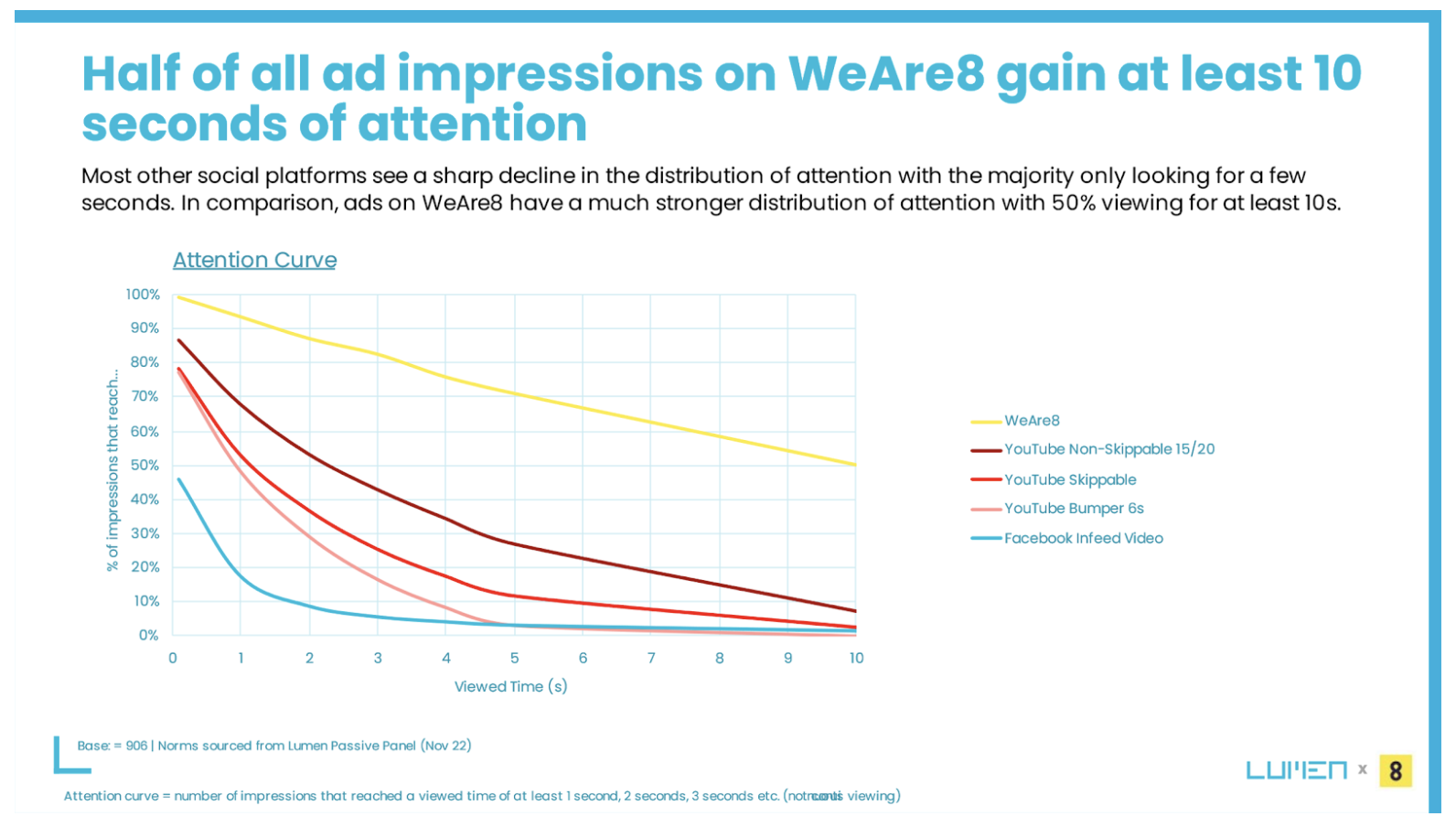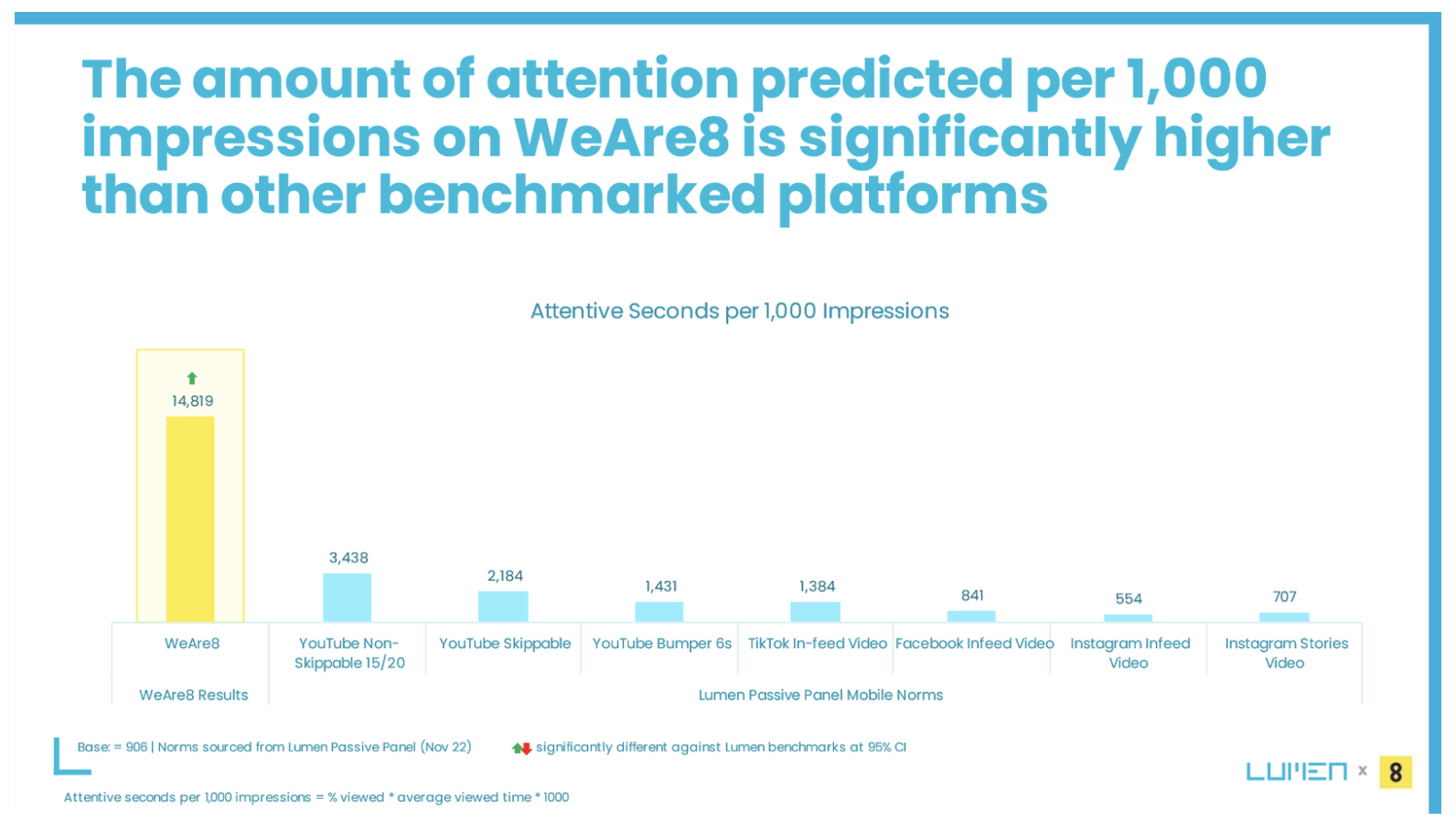Lumen Finds WeAre8 Has Extraordinary Attention Power

Six months ago, I wrote an article here called Make Real Connections that featured a meta-analysis of many custom research studies done by brands using the WeAre8 social media platform. WeAre8 is unlike everything else in marketing and advertising because it reflects a different social compact between the advertiser and the audience. Instead of the standard interruptive approach and other approaches (e.g., product placement) which occur without the voluntary consent of the audience, WeAre8 is based on the audience agreeing to look at and answer a few questions about a piece of brand content (typically a video from 15 to 45 seconds long), for which the audience gets paid, and a donation is made in the name of the audience member to a charity.
The meta-analysis of custom studies showed high scores in average conversion (58%), purchase intent (72%), brand awareness (83%) and brand favorability (66%). Heineken and Fairtrade were willing to be quoted in that article and wrote enthusiastically about the novel advertising method.
I was excited by these results and by the thoughtfulness of the approach, having written for decades about the need to establish real human connections between brands and people, and having suggested other approaches such as the non-salesy video brand content used in TV/streaming ad pods. The WeAre8 user experience is an unrushed affair in which people are being treated with the utmost respect and can see how their time given to the brand helps people through the specific charity involved. It creates a whole different headspace from the slick, impersonal messaging that has been used for a century or more.
I recommended to WeAre8 that they standardize their research (which has always been done by third parties) so that meta-analyses are a snap to conduct regularly, and that they invest in other third party research to compare performance on a head-to-head basis with other forms of advertising. At the time, WeAre8 was deployed in the U.K. and today they are in the U.K. and Australia. In both countries, Lumen has now performed a study which does just that: It compares WeAre8 attention against regular advertising attention. As you might expect, the degree to which a person pays attention to the WeAre8 brand video far exceeds that of a normal ad in the wild.

Because of the human relationship established by the WeAre8 social contract, more than half of the audience is attentive for at least ten seconds in the WeAre8 environment. Conventional environments typically score in the range of one to three seconds of attention.

Lumen’s technology provides more than just eyes on screen. It also reports a heat map of where the audience is looking within the screen (see video below).
The report also measured advertiser outcomes, averaging a +19% increase in brand favorability. Seventy-four percent of respondents said that "the WeAre8 platform made me think more favorably about the brands advertised." It's obvious even to the general public that this kind of arrangement -- in which the brand and the audience agree upon a plan of cooperation, and both the user and a charity benefit -- puts an advertiser into a completely different light than the traditional approach.
WeAre8 brings up the underlying question which we've discussed here many times, which is, "What does the brand give up by requiring all media buys to stay within a narrow range of CPM?" Efficiency across an entire brand's marketing plan is very important because without a high degree of efficiency, even high investment will not reach all prospects at the times when they are in market for your product. But by ruling out any buy, regardless of its impact, based on CPM, powerhouse impact vehicles such as WeAre8 are excluded from general use. This kneejerk reaction causes potentially huge opportunity costs for brands. A better decision would be to allocate a percentage of the media budget to high-impact buys regardless of CPM. That percentage can then be optimized over time by closed feedback loop analysis of results. To some extent advertisers have always done some of the latter, as we see in Super Bowl buys and branded integrations. WeAre8 is a newcomer entering this sphere of high impact alternatives, and brands would be wise to gain first mover advantage in participating.
Self-published at MediaVillage through thewww.AvrioB2B.complatform.
Click the social buttons to share this content with your friends and colleagues.
The opinions and points of view expressed in this content are exclusively the views of the author and/or subject(s) and do not necessarily represent the views of MediaVillage.com/MyersBizNet, Inc. management or associated writers.


